

Do you ever feel like you’re sleepwalking through life with no real idea of what you want?
Perhaps you know exactly what you want to achieve, but have no idea how to get there.
That’s where goal setting comes in. Goals are the first step towards planning for the future, and play a fundamental role in the development of skills in various facets of life, from work to relationships and everything in between. They are the target at which we aim our proverbial arrow.
Understanding the importance of goals and the techniques involved in setting achievable goals paves the way for success.
In the words of Pablo Picasso:
Our goals can only be reached through a vehicle of a plan, in which we must fervently believe, and upon which we must vigorously act. There is no other route to success.
Before you continue, we thought you might like to download our three Goal Achievement Exercises for free. These detailed, science-based exercises will help you or your clients create actionable goals and master techniques to create lasting behavior change.
Goal setting is a powerful motivator, the value of which has been recognized in an abundance of clinical and real-world settings for over 35 years.
‘Goals,’ are “the object or aim of an action, for example, to attain a specific standard of proficiency, usually within a specified time limit.” (Locke & Latham, 2002, p. 705) They are the level of competence that we wish to achieve and create a useful lens through which we assess our current performance.
Goal setting is the process by which we achieve these goals. The importance of the goal-setting process should not go unappreciated. According to Lock (2019) “Every person’s life depends on the process of choosing goals to pursue; if you remain passive you are not going to thrive as a human being.”
Goal-setting theory (Locke & Latham, 1984) is based on the premise that conscious goals affect action (Ryan, 1970) and conscious human behavior is purposeful and regulated by individual goals. Simply put, we must decide what is beneficial to our own welfare, and set goals accordingly.
Why do some people perform better on tasks than others? According to Ryan (1970), if individuals are equal in ability and knowledge, then the cause must be motivational.
The theory states that the simplest and most direct motivational explanation of why some people perform better than others is due to disparate performance goals, implying that setting and adjusting goals can significantly impact performance.
Initially, research into goal setting attempted to ascertain how the level of intended achievement (goal) is related to the actual level of achievement (performance) in an organizational setting (Locke & Latham, 1990).
Goal setting increases employee motivation and organizational commitment (Latham, 2004). Additionally, goals affect the intensity of our actions and our emotions. The more difficult and valued a goal is, the more intense our efforts will be in order to attain it, and the more success we experience following achievement (Latham & Locke, 2006).
Through the experience of success and the positive emotions that accompany it, confidence and belief in our own abilities grow. Schunk (1985) found that participation in goal setting encourages a search for new strategies to aid success. Finding novel ways to utilize our skills and push our abilities increases task-relevant knowledge while enhancing self-efficacy and self-confidence.
Goal setting involves planning for the future. MacLeod, Coates & Hetherton (2008) found that goal setting and skill-oriented planning significantly improved subjective wellbeing in those who took part in a goal-setting intervention program. Thinking positively about the future bolsters our ability to create goals and consider the actions required to achieve them.
The capacity to plan positively impacts our perceived control over goal outcomes and our future (Vincent, Boddana, & MacLeod, 2004). Furthermore, goal setting and achievement can promote the development of an internal locus of control.
While individuals with an external locus of control believe that both positive and negative outcomes are the result of external influences, those with an internal locus of control believe that success is determined by their own actions and skills.
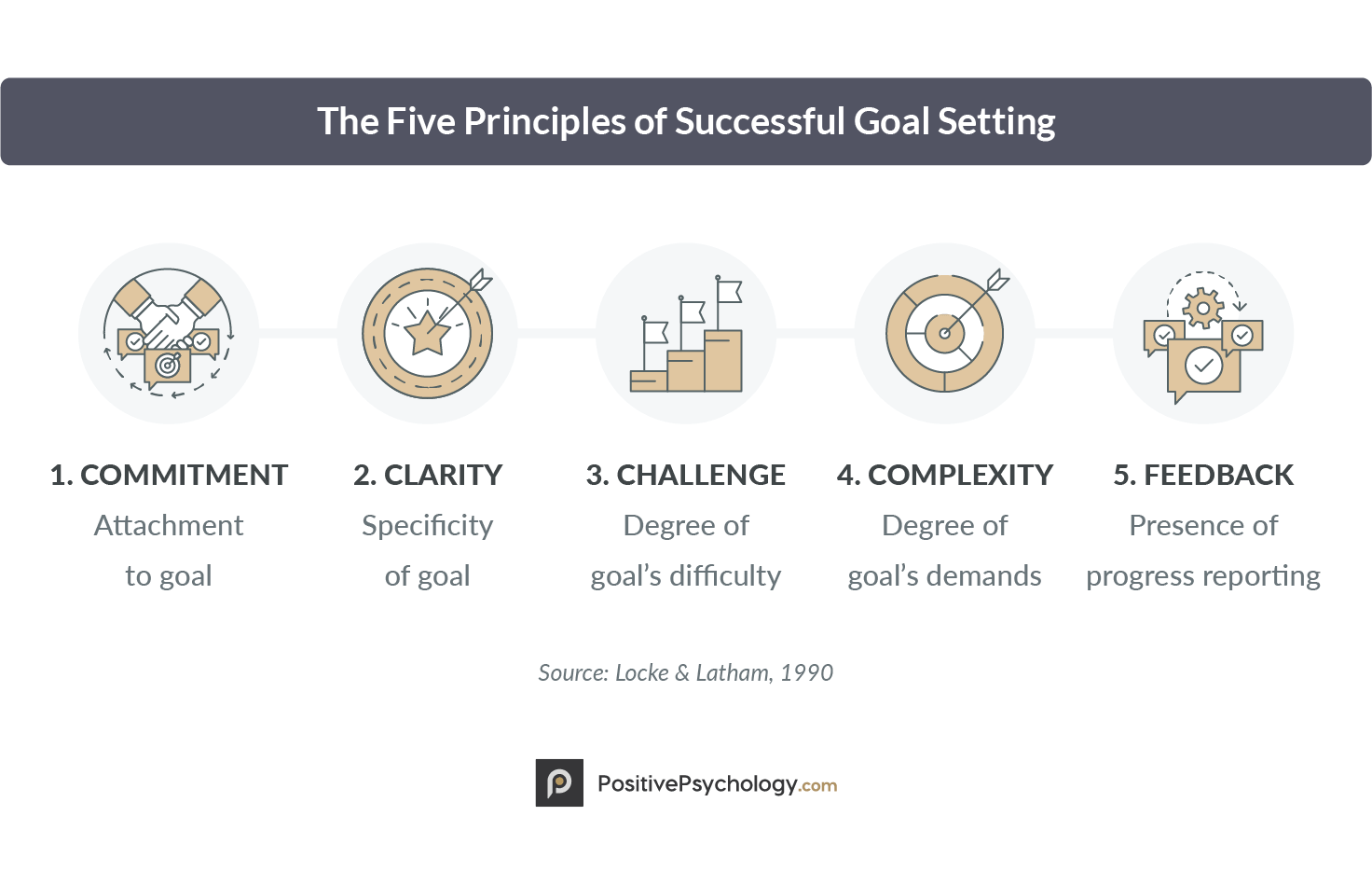
Locke and Latham suggested five key principles for successful goal achievement (Locke & Latham, 1990).
Commitment refers to the degree to which an individual is attached to the goal and their determination to reach it – even when faced with obstacles. Goal performance is strongest when people are committed, and even more so when said goals are difficult (Locke & Latham, 1990).
Once they’re committed, if an individual discovers their performance is inadequate, they are likely to increase their effort or change their strategy in order to attain it (Latham & Locke, 2006).
When we are less committed to goals – particularly more challenging goals – we increase the likelihood of giving up.
A number of factors can influence our commitment levels (Miner, 2005). Namely, the perceived desirability of a goal and the perceived ability of achieving it. To be successful, you must possess the desire and a comprehensive understanding of what is required to achieve your goal.
Specific goals put you on a direct course. When a goal is vague, it has limited motivational value. Goal clarity is positively related to overall motivation and satisfaction in the workplace (Arvey et al., 1976).
Set clear, precise and unambiguous goals that are implicit and can be measured. When a goal is clear in your mind, you have an improved understanding of the task at hand. You know exactly what is required and the resulting success is a further source of motivation.
Goals must be challenging yet attainable. Challenging goals can improve performance through increased self-satisfaction, and the motivation to find suitable strategies to push our skills to the limit (Locke & Latham, 1990). Conversely, goals that are not within our ability level may not be achieved, leading to feelings of dissatisfaction and frustration.
We are motivated by achievement and the anticipation of achievement. If we know a goal is challenging yet believe it is within our abilities to accomplish, we are more likely to be motivated to complete a task (Zimmerman et al., 1992).
Miner (2005) suggested that overly complex tasks introduce demands that may mute goal-setting effects. Overly complex goals that lie out of our skill level may become overwhelming and negatively impact morale, productivity, and motivation.
The timescale for such goals should be realistic. Allowing sufficient time to work toward a goal allows opportunities to reassess the goal complexity, while reviewing and improving performance. Even the most motivated of people can become disillusioned if the task’s complexity is too great for their skills.
Goal setting is more effective in the presence of immediate feedback (Erez, 1977). Feedback – including internal feedback – helps to determine the degree to which a goal is being met and how you are progressing.
Unambiguous feedback ensures that action can be taken if necessary. If performance falls below the standard required to achieve a goal, feedback allows us to reflect upon our ability and set new, more attainable, goals. When such feedback is delayed, we cannot evaluate the effectiveness of our strategies promptly, leading to a potential reduction in the rate of progress (Zimmerman, 2008).
When we perceive our progress towards a goal as adequate, we feel capable of learning new skills and setting more challenging future goals.

These detailed, science-based exercises will help you or your clients create actionable goals and master techniques for lasting behavior change.
Download PDF
By filling out your name and email address below.

A multitude of studies has shown that setting challenging yet attainable goals increases the prospect of pursuing and fulfilling ambitions.
The setting of clear goals is more likely to close the gap between current ability and the desired objectives. With this in mind, let’s look at some of the research related to goal setting.
The increasing prevalence of team-based structures in the workplace encouraged research in goal setting within teams. Such research indicated structural differences between goal setting for individuals and for groups (Locke & Latham, 2013).
Kozlowski and Klein (2000) suggested that while the effectiveness of individual and team goals may look similar when considering the final outcomes, the structure of the goal-setting construct is very different.
In team-based structures, individuals must engage in interpersonal interaction and various other processes in order to accomplish the team’s goal. Kristof-Brown and Stevens (2001) examined how perceived team mastery and performance goals affected individual outcome. Their findings suggested that agreement on team performance goals elicited greater individual satisfaction and contributions, regardless of goal strength.
Within virtual teams (workgroups in which members collaborate remotely), designing interactions that encourage the setting of goals leads to the achievement of shared mental models (Powell, Piccoli, & Ives, 2004). The addition of intermediate goals in addition to final goals, and clearly articulating them, significantly improved task performance within virtual groups (Kaiser, Tuller, & McKowen, 2000).
Research by Powell, et al. (2004) suggested that virtual groups should employ someone who is responsible for sharing goal-critical information, known as a caretaker. The inclusion of a ‘caretaker’ ensures each virtual team member’s efforts are aligned with those of the group, that there is role clarity, and that each teammate’s contribution advances the team toward its goals.
The setting of educational goals in academia ensures learners have an unequivocal understanding of what is expected, which in turn aids concentration on the attainment of their goals (Hattie & Timperly, 2007).
Reis and McCoach (2000) suggested that specific characteristics are commonly associated with academic underachievement. These include low motivation, low self-regulation, and low goal valuation. For children, self-regulation and motivation are affected by perceived goal and achievement values. When a goal is valued, children are more likely to engage in, expend more effort on, and perform better on the task
Further research by McCoach and Siegle (2003) found that valuing a goal was a necessary prerequisite to one’s motivation to self-regulate and to achieve in a scholastic environment. Additionally, students’ beliefs in their efficacy for self-regulated learning influenced the academic goals they set for themselves and their final academic achievement (Zimmerman, 2008).
Goal setting is at the core of many neurological rehabilitation therapies. Holliday, Ballinger, & Playford (2007) explored how in-patients with neurological impairments experienced goal setting and identified the issues that underpin individual experiences of goal setting.
Their findings suggested that within rehabilitative healthcare professions, it is vital that patients understand what is expected of them in order to ensure goal setting is a meaningful activity.
Goal setting is a traditional method used within the practice of physical therapy. Cott and Finch (1991) examined the potential use of goal setting in improving and measuring physical therapy effectiveness. The study suggested that active participation by the patient in the goal-setting process is of primary importance to the attainment of goals.
That is, inclusion in the formation of goals rather than having them externally imposed is imperative.
When done correctly, goal setting is effective and often critical to success. Goals give us direction by focusing attention on goal-relevant behavior and away from irrelevant tasks (Zimmerman, Bandura, & Martinez-Pons, 1992). Miner (2005) suggested that goal setting works through three basic propositions:
As previously discussed goals that are specific and challenging lead to higher levels of performance. Locke and Latham (1990) suggested that these types of goal strategies work more effectively for the following reasons:
There are some essential skills required for successful goal setting and achievement.
The good news is they can be learned and developed through practice. If you cannot achieve the goals you have set, it is possible that the problem lies in one or more of these areas:
The old adage ‘fail to plan, plan to fail’ is applicable to successful goal achievement. Low-quality planning negatively affects performance in relation to goals (Smith, Locke, & Barry, 1990). Planning and organizational skills are integral to the goal achievement process. Through proper planning, we can prioritize and maintain focus on the task at hand, while avoiding extraneous distractions that can draw us away from the end goal.
Without the desire to achieve, our attempts at goal setting are doomed to fail. Motivation to achieve a goal encourages us to develop new techniques and skills in order to succeed (Locke, 2001). In more challenging circumstances, the motivation to keep going is a powerful contributor to goal attainment.
Time management is a useful skill across many facets of life including goal setting. While setting goals is commonly considered being a specific time management behavior (Macan, Shahani, Dipboye, & Phillips, 1990), time management is also required to successfully accomplish a goal. If we do not properly consider the timescale required to attain a goal, we will inevitably fail.
Additionally, the time we allocate to planning our goals directly impacts task performance – the more time spent on the planning stage, the more likely we are to succeed (Smith, Locke, & Barry, 1990).
Inevitably, at some point, things aren’t going to go as planned. Having the flexibility to adapt to barriers, the perseverance to sustain your efforts and to carry on in the face of adversity is essential to reaching your goal.
An individual needs to regulate and manage their own emotions in order to promote their own personal and social goals. With developed Emotional Intelligence comes the ability to efficiently consider and describe motivational goals, aims, and missions (Mayer, 2004).
If we are not committed to our goals, goal setting will not work (Locke, 2001). It is imperative that goals are important and relevant on a personal level, and that we know we are capable of attaining, or at the very least making substantial progress towards, a goal.
Personal goal setting is a personal endeavor–only you know what you want to achieve.
The following outline will help focus your attention on the personal goal-setting process and guide you in the right direction for successful personal goal attainment.
It might be tempting to approach goal setting with gusto, and while enthusiasm is a good thing it is important not to rush into too much too soon. By limiting the number of goals you initially set there is less chance that you will become overwhelmed by the tasks ahead. Setting just a few initial goals will allow you to make a start on the journey while avoiding the negative emotions that accompany failure.
As you begin to achieve your objectives, try setting more challenging, longer-term goals to push your abilities even further. Once your goals are set, remember to review them regularly. When you begin the goal-setting process it may be beneficial to revisit your progress daily or weekly depending on the goal.
Initially, it is better to set short-term and more realistic goals. Setting short-term goals such as “I will learn to make pancakes by next week” enables more frequent opportunities to review and acknowledge the achievement of goals. More frequent experiences of success result in greater positive emotions and increased motivation to set additional goals or a combination of short, medium and long-term goals.
Reframe negative goals such as “I want to stop eating so much junk food” into more positive terms like “I want to feel healthy and will change my diet in order to do so”. With negative goals, the initial motivation often comes from a place of negativity. For example, “I want to stop eating so much junk food because I feel unattractive.” These negative connotations can lead to self-criticism and de-motivation.
Failure to achieve a positive goal is viewed as an indication that while we may have failed at least we are still on the right path.

The Positive Psychology Toolkit© is a groundbreaking practitioner resource containing over 500 science-based exercises, activities, interventions, questionnaires, and assessments created by experts using the latest positive psychology research.
Updated monthly. 100% Science-based.
“The best positive psychology resource out there!”
— Emiliya Zhivotovskaya, Flourishing Center CEO
There are three prominent areas where you can practically apply goal setting.
Goal setting is a robust method of support for positive mental health (Rose & Smith, 2018).
When considering the goals you would like to achieve in relation to psychological health, think about what you want to change and how you want to go about changing it. Achieving goals in any aspect of life can boost self-esteem and self-efficacy, leading to improvements in confidence and wellbeing.
Janet has been thinking about her wellbeing and wants to make changes to improve her mental health. Within this area, goals such as “I want to be happier” are too vague and will create barriers to achievement. Janet settles on the more specific goals of “I will do one thing every day that makes me happy”. This is much more realistic and can easily be reviewed.
Canevello and Crocker (2011) suggested that goals contribute to the cycles of responsiveness between people and improve relationship quality. Interpersonal goal setting allows us to create higher quality relationships characterized by improved responsiveness that ultimately enhance relationship quality for everyone involved.
Toby decides he wants to spend more time with his family, after thinking about how he can do this he feels that the problem may be related to the many late nights he has been spending at work. Toby decides, “I will make sure I am home from work every night before the children go to bed”.
While this may seem like a specific goal, there is still much ambiguity. What if he has to work late in order to meet a deadline? Both he and his children will feel disappointed and frustrated with this outcome.
After reviewing his goal, Toby makes some alterations: “I will make sure I am home from work 2 days a week so that I can see the children before bedtime”. By adding specifics, he has made his goal more achievable and measurable. On reviewing his goal progress, Toby might then decide to change his goal to three times per week if experience tells him this is attainable.
Money, or lack thereof, can massively influence our mental health and wellbeing. It is impossible to know what life will throw at you – illness, redundancy, unexpected expenditure.
In this category, like many others, short term, smaller goals are often more likely to result in success. Perhaps you have debt that you want freedom from or even just a rainy day savings fund. Whatever your financial goal, small positive steps to taking control of your finances can make a big impact.
Jenny has been thinking about her finances and decides she wants to start building her savings. Rather than setting the vague goal, “I want to save money,” she thinks in more detail about her objective and sets the goal “I will save $500 in the next 8 weeks.” By making the goal more specific and measurable, Jenny has improved the likelihood of actually achieving her goal.
The goal can now be reviewed when she decides to and it will be clear if she is on track.
Goal Setting ModelIn the 1980s, business coaches Graham Alexander, Alan Fine, and Sir John Whitmore developed the GROW goal setting model, which has become a very influential and effective coaching framework (Nguyen, 2018).
The core of the model relies on four pillars:
– Goals
Setting clear goals that align with our core values is important for increasing engagement with actions that will make those goals a reality.
– Reality
Being aware of our current state in relation to our goals, including what’s working well, as well as the possible barriers (e.g., excuses, fears, weaknesses), is key for making positive changes aligned with our goals.
– Options
Acknowledging the possible routes for action, our own strengths, as well as our available resources (e.g., peer support) can help us use our options to get back on track when faced with obstacles.
– Way forward
Motivation, commitment, and accountability towards making positive changes now are crucial in getting us started on our journey towards achieving our goals.
Many revisions of this model have been suggested since it was first developed, such as adding the “Tactics” and “Habits” components (GROWTH). However, the core model remains the same and is used across various contexts, including workplaces, couples, families, and the individual level.
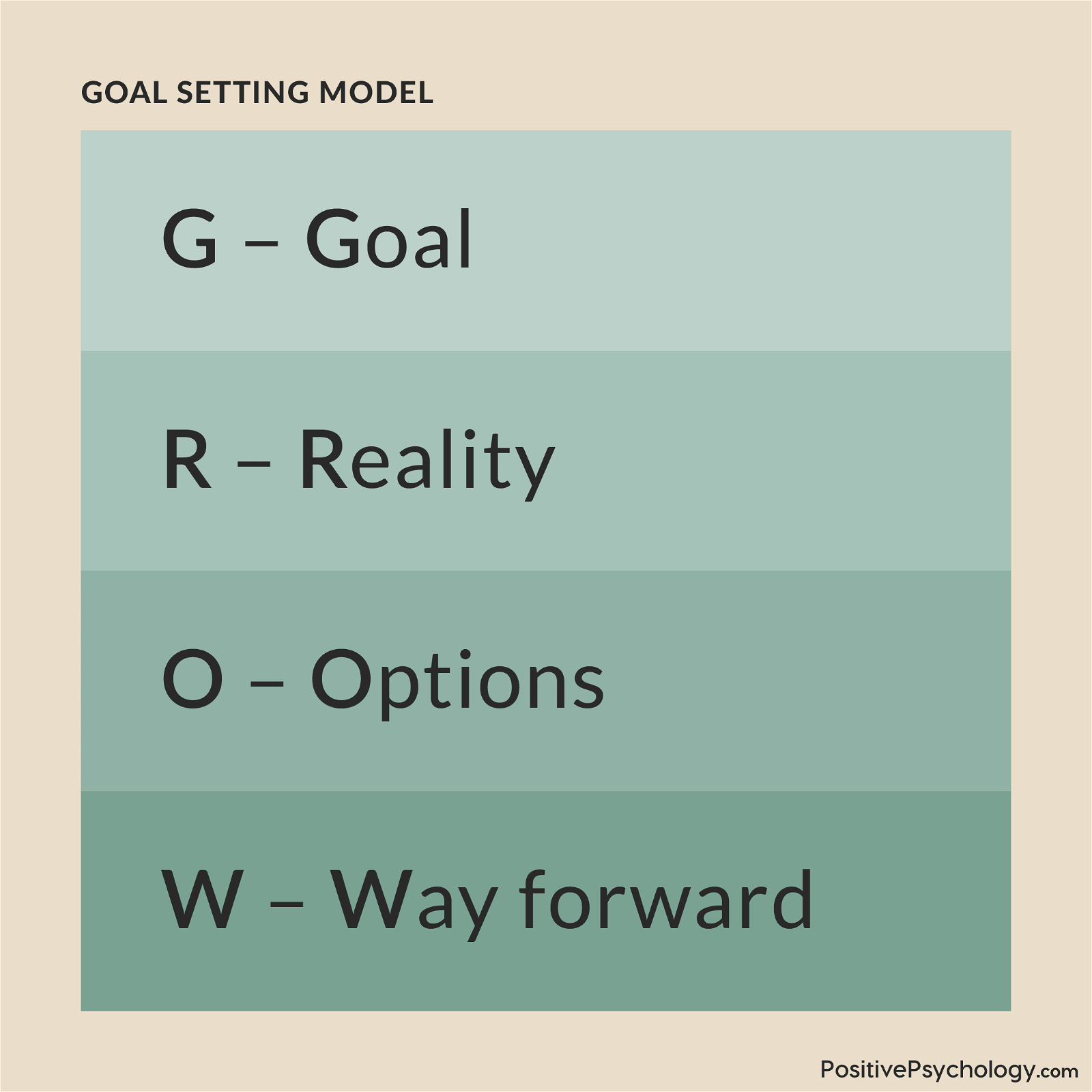

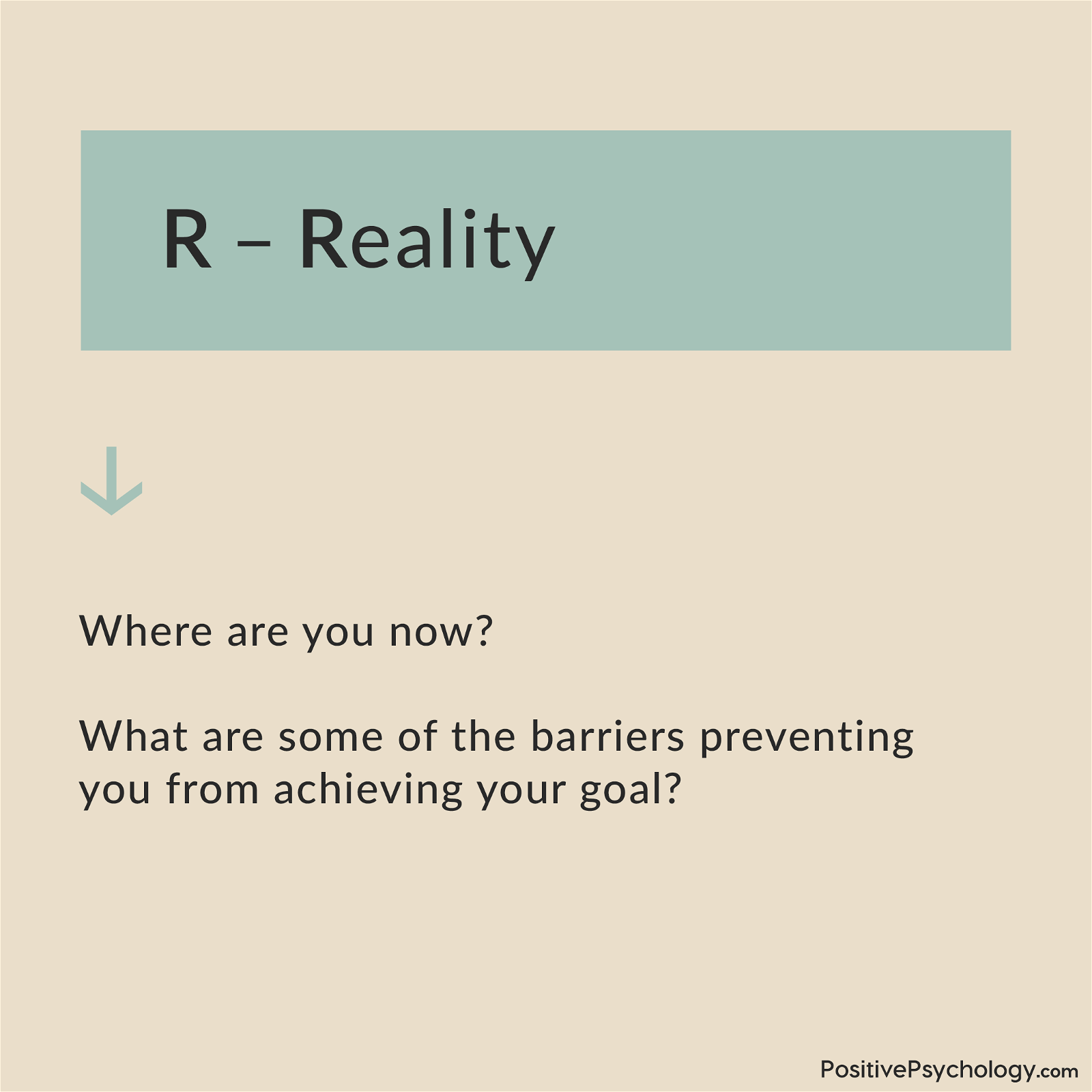
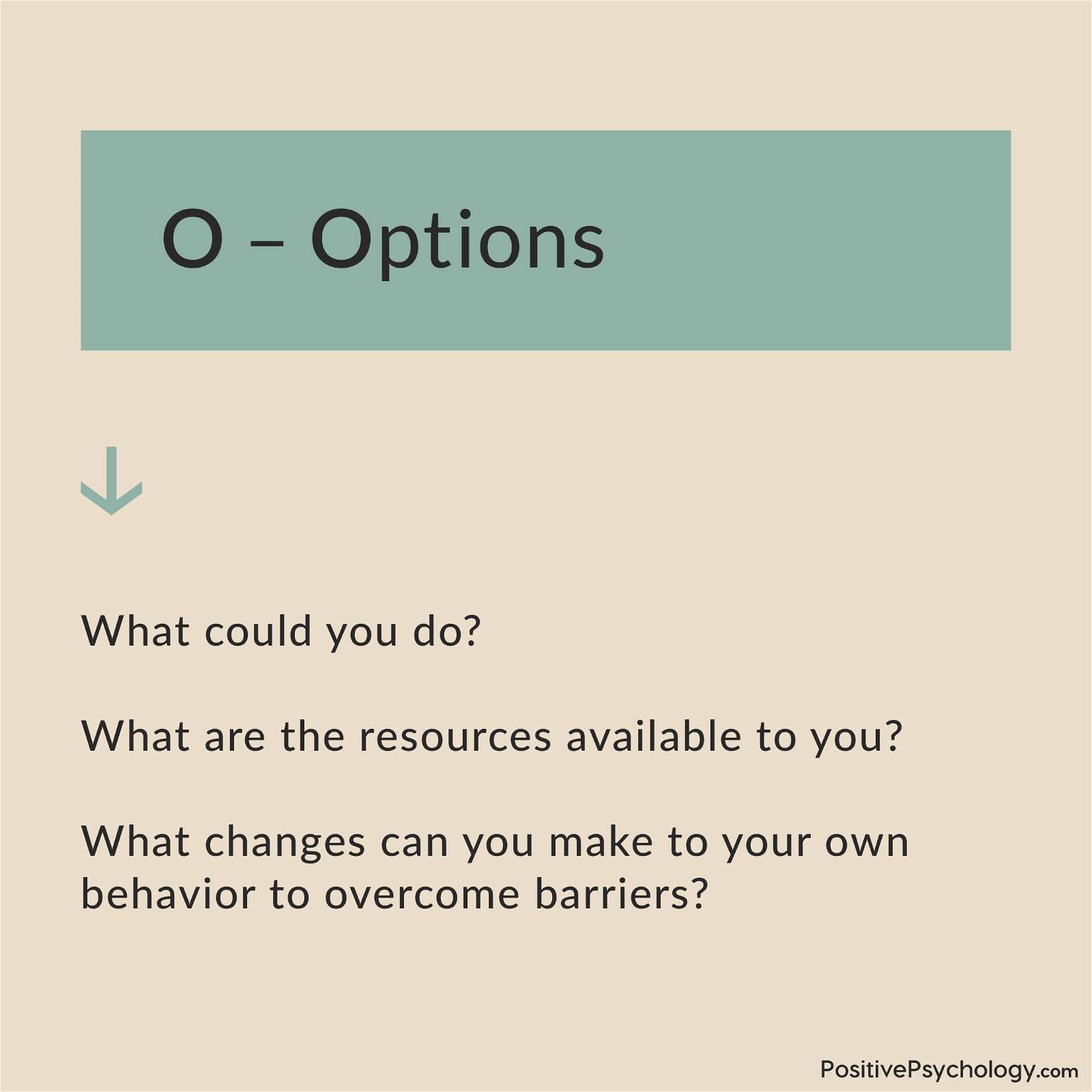
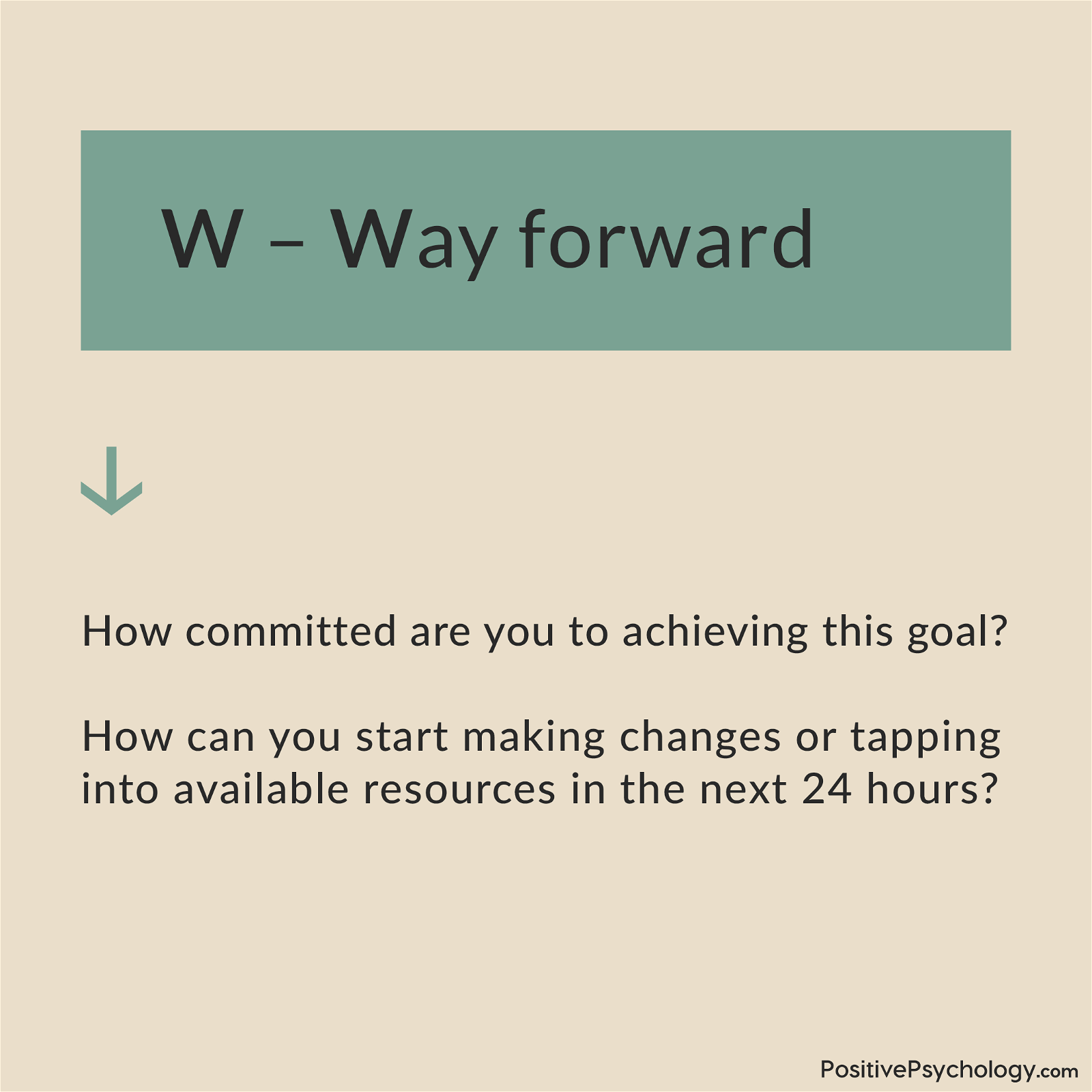
This PDF: ‘Workbook for Goal-setting and Evidence-based Strategies for Success’ provides an abundance of exercises and worksheets to teach the reader the best practices for designing, pursuing and achieving important goals.
Compiled by Caroline Adams Miller, MAPP, author of ‘Creating Your Best Life: The Ultimate Life List Guide’, the 90+ page workbook provides a structured approach to guide readers towards successful goal setting.
This workbook/guide draws input from a number of areas, including work on “flourishing” from positive psychology founding father, Dr. Martin Seligman. It presents a thorough 6-theme process which guides readers to successful goal setting and provides an in-depth review of the underlying psychology.
Anxiety Canada’s PDF ‘Guide for Goal Setting’ provides a simple but effective guide on how to identify, set, and achieve realistic goals. The guide handily breaks down the process into easy-to-follow steps while prompting readers to view their future prospects in a positive light.
In brief, the guide is broken down into five steps:
The guide is a really great overview of goal-setting practices and represents a fantastic starting point if you’re keen to jump right into the practice of goal-setting.
The University of Exeter’s PDF, ‘Goal Setting’ for the physically impaired, was compiled by BABCP-accredited Cognitive Behavioral Psychotherapist, Dr. Paul Farrand and associate research fellow – Joanne Woodford. The guide focuses on goal setting for individuals facing physical health problems.
Alongside goal-setting advice, the guide contains worksheets for tracking their progress.
Once your goals are set, it is important to revisit and reassess them. Reviewing goals affords the opportunity to assess progress and to ensure they are still relevant.
While some goals can be achieved relatively quickly, others take time, patience and lasting motivation to continue. The frequency with which goals should be reviewed is very much dependent on the goal itself. What is more certain is that you should plan to review your goals regularly.
If, for example, you have set yourself smaller milestones to reach on the route to your final goal, it may be prudent to review these on a weekly basis. Being aware of your progress allows opportunities to alter your actions and goals so as not to undermine the hard work you have already put in.
Perhaps things aren’t quite going as planned, regular reviews allow you to reflect on the difficulty of the goals you have set. Is the goal more challenging than you expected? What can you improve upon to attain it?
Regular goal reviews ensure the goal is still relevant – is this still what you want to achieve? If you do not ‘check in’ on your progress, you can lose sight of your ultimate aim which will result in disappointment, frustration and less motivation to attain it than when you first began your journey.
Time-based goals such as learning a new language can take months or even years to complete. When working towards these types of long term goals, it is a good idea to break them down into more manageable targets that can be reviewed weekly.
Essentially, reviewing your goals ensures that you are monitoring your progress in relation to successes and failures. It gives you the chance to analyze the good and bad, so that you can regroup, build on that knowledge, and improve future goal setting strategies.
Have you ever made a grand New Year’s resolution only to find that by the middle of January, you’ve given up or forgotten all about it? You may have set yourself a goal that was too general, ambitious, or impersonal. Incorporating healthy goal-setting techniques is an excellent way to tackle these issues.
The S.M.A.R.T. protocol offers a guide to help steer you towards setting goals that are suited to your abilities, timely, and measurable. If you are unsure of the goal-setting process, the S.M.A.R.T framework offers a sense-check to ensure your goals are the best they can be.
Be as specific as possible when setting goals. Look at the what, why, where, when and how of a goal. What do I want to achieve? How will I get there? When should I have achieved this goal by?
Having a goal which can be quantified makes it a lot easier to track your progress.
The goals we set need to be grounded in reality lest we set ourselves up for disappointment.
Focus more intently on the subjective ‘why’. Is the goal something you actually want to achieve, or does it stem from external pressure?
Create a clear yet achievable timescale. Deadlines maximize the reward versus time component. Be explicit about the time span or deadline. For example, change ‘end of summer’ to a specific date for improved clarity.
It may seem like an unnecessary additional effort, but there is value in putting pen to paper. Write down your goals and think carefully about the steps involved to get there. The very act of writing something down improves recall (Naka & Naoi, 1995), and having a physical reminder of what you want to achieve means you can check-in and review it at any time.
Consider the timescale in which you wish to achieve your target. If your goal is a particularly challenging one, break it down into smaller, more manageable goals that culminate in attaining your main goal.
Rather than saying “I want a promotion”, consider the smaller steps that will help get you to that goal, “In the next 4 weeks I will commit to taking on a project I haven’t tried before”. Whatever you decide, ensure it is right for you.
How we articulate goals to ourselves is integral to the outcome of our efforts. Rather than a blanket statement, more specific goals will be much more effective. Rethink your objectives by presenting them in more specific terms, then build on that.
This doesn’t mean rewarding yourself with chocolate when you attain a healthy eating goal, rather an internal pat on the back. Acknowledge your success and revel in the positive emotions that accompany it.
It is important to be resilient in the face of adversity. Reassess your goals and make alterations when you feel it is necessary to do so.
It’s great to shoot for the stars, but goal setting is more about what you can realistically accomplish rather than an idealistic vision of what you hope you can achieve.

These 17 Motivation & Goal Achievement Exercises [PDF] contain all you need to help others set meaningful goals, increase self-drive, and experience greater accomplishment and life satisfaction.
Created by Experts. 100% Science-based.
To culminate this extensive guide on goal-setting, we leave you with a final list of tips and strategies.
Consider what you want to accomplish and be specific in your goals. Really think about your core values and what outcome you are reaching for and write them down. Clear goals will ensure a comprehensive understanding of what is required in order to achieve them. Take the time to really reflect on what you want.
This logical thinking process tool is an excellent way to maintain focus on your goal while considering the strategy you might use to achieve it. The very top of the tree is the end goal – your mission statement. On the next level are a maximum of five objectives that are critical to attaining your main goal.
Under the objectives are the necessary conditions required to achieve each one. A goal tree is like a map to success, over time each step is color coded as it is completed, meaning that you can easily review your progress at a glance.
If you set an unrealistic goal, it may well discourage you from continuing with your endeavor.
Feedback is superior to no feedback, and self-generated feedback is more powerful than externally generated feedback (Ivancevich & McMahon, 1982).
After setting your goal, feedback is the best way to assess how well you are doing. Try setting up a schedule where you can ‘check-in’ on your progress every week. Do you need to reassess and redefine your goal?
Intermittent reinforcement involves interspersing easier, more achievable goals among more challenging, difficult goals (Martin & Pear, 2019). The completion of each smaller goal becomes rewarding in and of itself, thus delivering the positive effect of success at regular intervals.
When we share our goals we are more inclined to exhibit accountability and strengthened commitment. If you tell a friend about a goal you have set, how will you feel if they ask about it and you haven’t been working towards it?
Believe in your abilities, but know that it’s OK if things aren’t going to plan. Reevaluating our progress and rethinking goals is all part of the process. Remember that any progress towards your goal is a good thing.
We all have the capacity to adapt and to achieve our personal expectations. Through goal setting, we raise the bar in relation to our own potential and push ourselves to achieve things we only hoped were possible.
Have you incorporated any goal-setting techniques to help you on your way to success? Or maybe you are tempted to make a start on your own plan? How are you going to turn your goal setting into goal getting? Let us know in the comments below.
We hope you enjoyed reading this article. Don’t forget to download our three Goal Achievement Exercises for free.
References